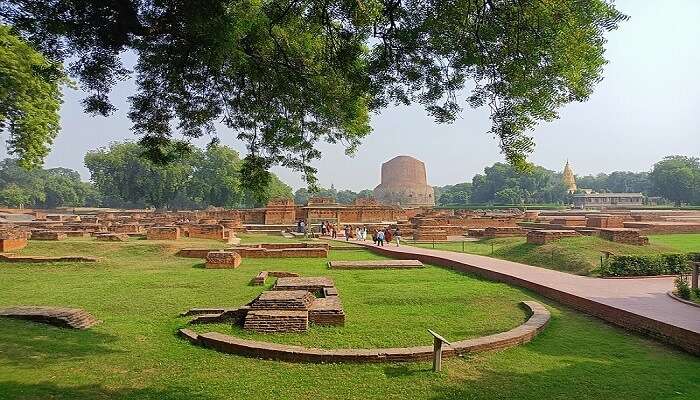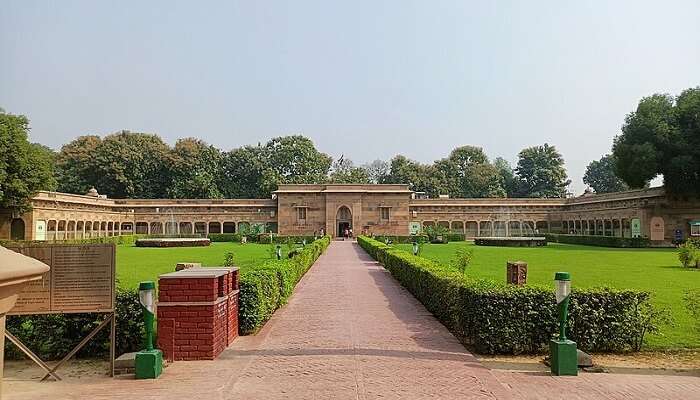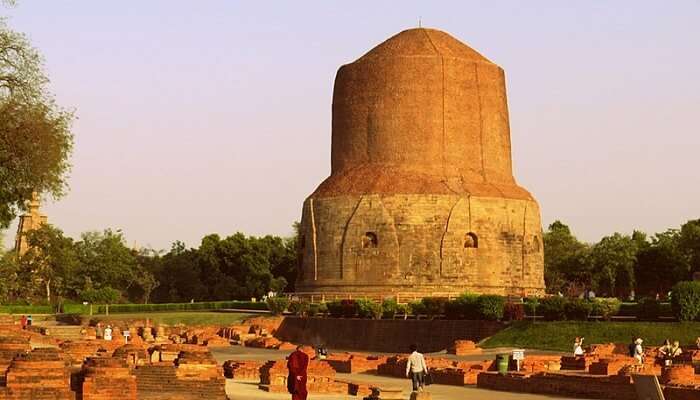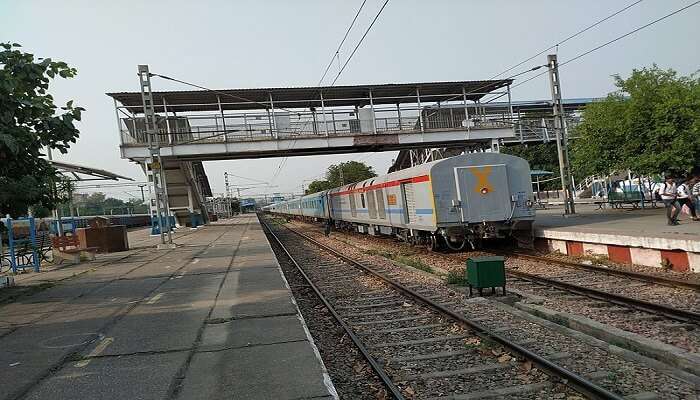The Deer Park in Sarnath is a prominent attraction at this archaeological site since it is believed to be where Gautam Buddha proclaimed Dhamma for the first time. The site of Sarnath itself owes its name to the Sanskrit words Sāranganātha, which signifies “Lord of the Deer.” The park was constructed by a king to create a deer sanctuary and today, it is home to different animals and birds. The Sarnath Deer Park is undoubtedly worth a visit if you want to learn about the area’s history and wish to spend some time in serenity.
About The Deer Park In Sarnath

Image Credit: SM7 for Wikimedia Commons
A beautiful green space in Sarnath, Deer Park is a treat for nature lovers as well as history buffs. It is one of Sarnath’s significant historical and religious sites since it is situated on the spot where Gautam Buddha supposedly proclaimed Dhamma for the very first time. Many believe that there were deer present there at that time. Sarnath is strongly associated with deer as its name is derived from Sanskrit, Sāranganātha, which symbolises “Lord of the Deer.” According to a Buddhist legend, there was a deer who offered to sacrifice itself in the place of a doe that was to be killed by a king. This deer was believed to be the Bodhisattva. Moreover, it is often said there was once a sage named Sarangnath who lived here.
The park has sprawling green lawns and is best known for its flora and fauna. The park has a zoo which comprises animals and birds like deer, crocodiles, pelicans, porcupines, cranes, white neck storks, ducks and more. If you’re lucky, you might be able to pet a deer but be careful! Furthermore, the park is great for taking a quiet stroll or boating. In fact, this is an especially ideal place to come to if you are travelling with children.
Must Read: Places To Visit In Sarnath
Importance Of Deer Park In Sarnath In Indian History

Image Credit: सत्यम् मिश्र for Wikimedia Commons
Due to its link to Buddhism, Sarnath is perhaps one of India’s most important pilgrimage sites. It is primarily an archaeological site that lies where the rivers Ganges and Varuna converge and is most notable for being the place Gautam Buddha delivered his very first sermon, sometime around 528 BCE, after he achieved enlightenment in Bodh Gaya. Sarnath is also one of the four Buddhist pilgrimage sites that Buddha deemed important to visit for followers of the religion. It is also where he shared his first discourse with his first five disciples, namely Vappa, Bhaddiya, Assaji, Mahanama and Kaundinya and where they themselves achieved liberation and enlightenment. What’s more, their attaining liberation led to the formation of a sangha.
Besides being one of the principal pilgrimage sites associated with Buddha’s presence, Sarnath has been a key part of Indian history as it was where attempts were made to spread the religion. This site was of great importance during the Mauryan and Gupta periods. Also, it became a key centre of learning about the word of Buddha and art and architecture. The Sammatiya school of Buddhism was established here, as was a monastery for monks. Interestingly enough, Sarnath has also come to be linked with both Hinduism and Jainism. There are images of Hindu deities like Lord Shiva and Lord Brahma that have been uncovered here and there is a Jain temple not too far from the revered Dhamek Stupa.
Top Attractions To Visit

Image Credit: Preeti Prajapati for Wikimedia Commons
Sarnath boasts of immense historical and religious heritage and is therefore home to many attractions that you musn’t miss out on, some of which are:
- Dhamek Stupa should perhaps be one of the first sites you visit in Sarnath since it is believed to have been built on the same spot where Gautam Buddha’s first five disciples attained liberation following his discourse with them. This stupa is about 43 metres tall and made of bricks and stone. Its construction has been linked to both the Mauryan and Gupta periods.
- The Sarnath Archaeological Museum was built in 1910 and is a great place to learn about the region’s past. It houses a collection of artefacts that go as far back as the 3rd century BC. You would need a ticket to enter this museum.
- You could visit the Mahabodhi Society Temple here that was built during the Gupta period and is one of India’s oldest temples. It is said to be where Gautam Buddha attained enlightenment and was built following the efforts of a Buddhist monk from Sri Lanka called Dharmapala. What’s interesting is that many of the paintings on its walls as its frescoes were made by Japanese artists.
- You simply cannot take a trip to Sarnath and not go to see the Ashoka Pillar which is close to Dhamek Stupa. It is about 50 metres tall and is made out of stone. On the top is a structure with four lions and it is now the national emblem. It was built to commemorate Ashoka the Great’s visit to Sarnath.
- You would also be interested in visiting the Tibetan temple, which is a beautiful structure featuring Thangka or Tibetan Buddhist paintings. On the outside are prayer wheels you can rotate to release paper scrolls with prayers.
Suggested Read: Places To Visit In Uttar Pradesh
Ways To Reach And Ideal Time To Visit

Image Credit: Ravi Dwivedi for Wikimedia Commons
Being well connected to many cities in Uttar Pradesh as well as in other parts of north India, getting to Sarnath is easy. You can choose to come by road which is perhaps the most convenient option. However, if you wish to avoid driving but still want to take the road, opt for a bus since there are many that run from the neighbouring city of Varanasi to Sarnath. If you opt to fly here, you must book a flight to the airport in Varanasi which is the closest one. It is about 25 km away and it shouldn’t take more than 40 minutes to drive from their to Sarnath. Lastly, you can take the train to either Sarnath’s own railway station or to the more frequented one in Varanasi about 8 km away.
If you can’t decide when to plan your trip to Sarnath, it makes most sense to visit in the winters. October to March are usually the ideal time to come here since the cool temperatures make outdoor excursions pleasant. However, if you aren’t too fond of the cold but wish to avoid the heat, perhaps you can plan a visit during the monsoon season, which usually lasts from July to September. This period is usually characterised by cool weather marked by some rainfall every now and then. The summer season from April to June in Sarnath is usually best to avoid since the temperatures can rise above 40 degree celsius, making any outdoor activities less enjoyable.
Further Read: Sarnath Hotels
Sarnath is one of those destinations that should be on your bucket list of places to explore in India. Its rich heritage is worth learning about, and plenty here would leave you in complete awe. And given its proximity to other cities in the state, planning a trip to Uttar Pradesh and visit the deer park in Sarnath with the family or your loved ones for a memorable holiday! So go on the internet now and book your tickets.
For our editorial codes of conduct and copyright disclaimer, please click here.
Cover Image credit : By Heshan93 for Wikimedia Commons.
Frequently Asked Questions About Deer Park In Sarnath
How much must one pay to enter the Deer Park in Sarnath?
Indians must pay INR 10 to enter this park while foreigners must pay INR 50.
Are the animals at Sarnath’s Deer Park dangerous?
No, the animals are not dangerous and are kept away from the spaces meant for people. However, you must make sure to maintain your distance and to not tease its animal inhabitants.
How much time can one spend at the Deer Park in Sarnath?
The park is open everyday from 8:00 AM to 5:30 PM so you can stay for as long as you’d like during these hours. However, you do not need more than 45 minutes to an hour to see this place.
Which festival is the most popular one in Sarnath?
The festival most famous in Sarnath is Buddha Purnima since it celebrates three very important moments in the life of Gautam Buddha, namely his birth, his attaining enlightenment and his death.
Which are the other 3 important Buddhist pilgrimage sites?
esides Sarnath, Lumbini, Bodh Gaya and Kushinagar are the other 3 principal Buddhist pilgrimage sites in India.
People Also Read:
Bandipur National Park Royal National Park Namaqua National Park

Innovative Content Writer Focused on Producing High quality, Original Content that drives traffic and engages readers. Experienced in Content strategy and analytics to measure content performance using tools such as SQL, Power BI, Excel.







